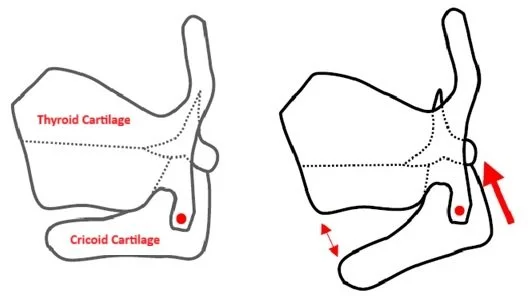If you’ve ever marveled at how professional singers float effortlessly into the upper reaches of their range, you may have wondered what makes their voices different from everyone else’s. The answer lies in a combination of anatomy and training. Recent research has given us a clearer picture of what’s happening inside the larynx when singers take on high notes.
The vocal folds work a bit like elastic bands. To produce pitches in the upper range, the vocal folds stretch and lengthen. A trained singer is capable of lengthening their vocal folds by nearly 20 percent across two octaves, as opposed to the typical 10 percent by those who do not practice singing (Storck et al., 2025). That extra flexibility allows singers to raise pitch without strain and with control.
The cricothyroid joint (CTJ) in the larynx can be likened to a small hinge that helps determine how easily the vocal folds can stretch. Some people are born with a joint structure that allows for smoother elongation, while others have a less mobile version. But the striking finding from this study is that training makes a greater difference than anatomy alone. Even those with less favorable joint types can sing effectively by strengthening the correct muscles (Storck et al., 2025).
The Role of Training
Professional singers achieve most of their vocal fold lengthening in the first octave above their speaking pitch. This foundation makes the second octave much easier to navigate. A 3D imaging study confirmed that nearly 85% of vocal fold stretching happens in the first octave, with only about 15% in the second (Unteregger et al., 2017). Non-singers, by contrast, don’t stretch the folds enough early on. To compensate, they often raise the larynx, narrowing the resonance space to “force” higher pitches. The result is more effort and less freedom in the sound. As a 2025 study from the University Hospital Basel found, non-singers likely increase pitch by elevating the larynx rather than by sufficient vocal fold elongation, underscoring the value of targeted training (Storck et al., 2025).
A Practical Takeaway
The good news is that these patterns aren’t set in stone. Training the cricothyroid muscle, the primary driver of vocal fold elongation, can be done through simple, time-tested exercises. Decades of voice science have demonstrated that this muscle plays a central role in pitch control (Hirano, 1988). Gentle glides (glissandos) on an open vowel encourage the folds to lengthen gradually, developing strength and coordination without strain. Over time, this training allows the voice to extend higher while staying balanced and resonant.
Final Thought
Reaching higher notes isn’t about possessing rare anatomy or extraordinary talent. It’s about teaching the voice to use its natural mechanisms more efficiently. With thoughtful practice, any singer, professional or amateur, can develop greater ease in the upper range, singing with both freedom and confidence.
Institute for Healthy Singing & Voice Research
Jamea J. Sale, PhD
Director, Institute for Healthy Singing & Voice Research
Sing for a Lifetime
JSale@HealthySinging.org
References
Hirano, M. (1988). Vocal mechanisms in singing: Laryngological and phoniatric aspects. Journal of Voice, 2(1), 51–69. https://doi.org/10.1016/S0892-1997(88)80058-4
Storck, C., Murer, R., Honegger, F., & Lieb, J. (2025). The influence of cricothyroid joint type on vocal fold elongation in professional male singers and non-singers. Journal of Voice. Advance online publication. https://doi.org/10.1016/j.jvoice.2025.09.015
Unteregger, F., Honegger, F., Potthast, S., et al. (2017). 3D analysis of the movements of the laryngeal cartilages during singing. Laryngoscope, 127(7), 1639–1643. https://doi.org/10.1002/lary.26430

